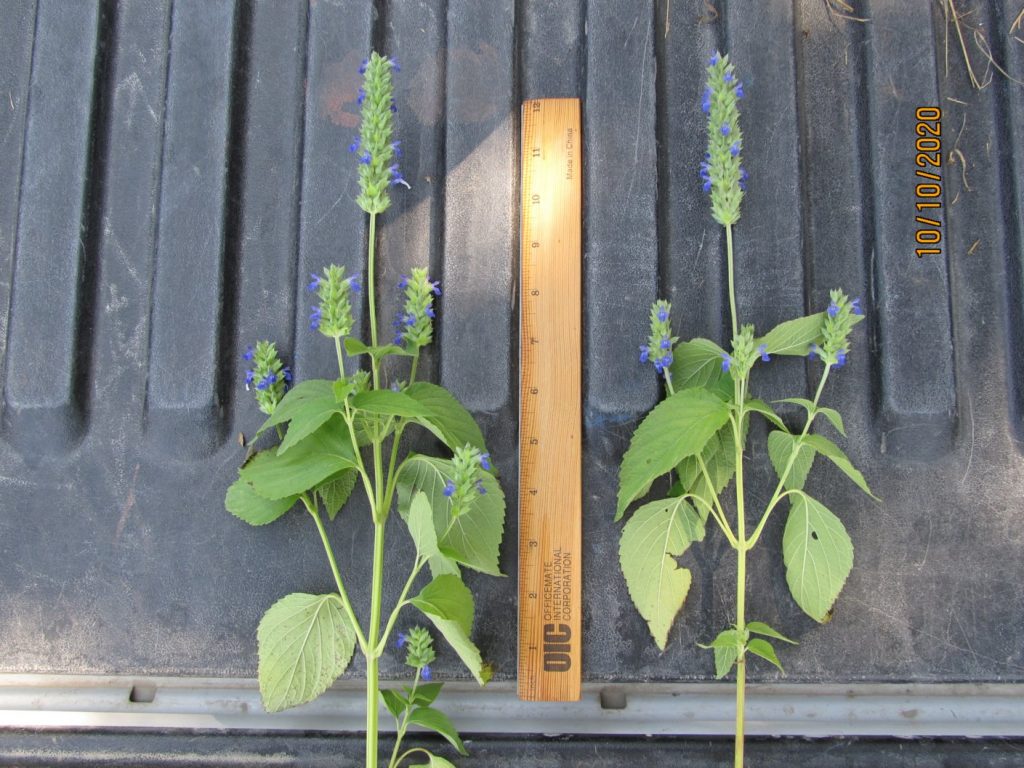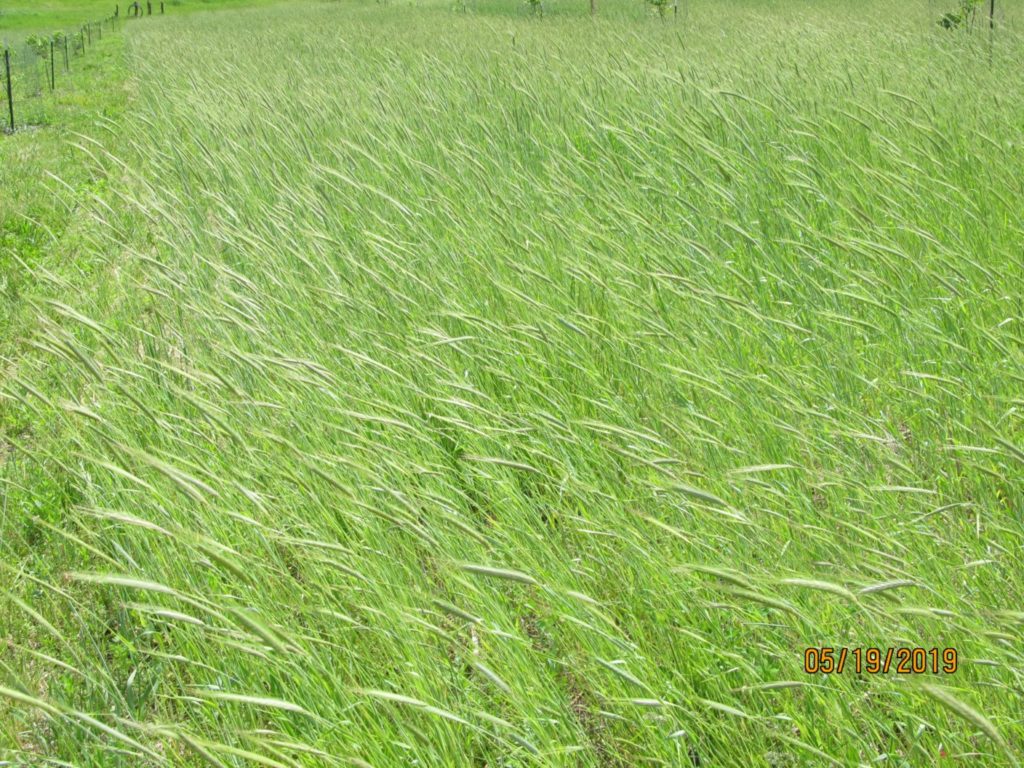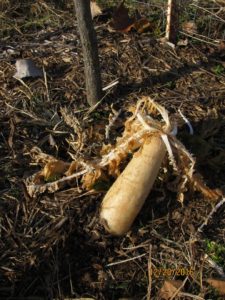Here are some pictures taken in October and November.



Here are some pictures taken in October and November.



With all the rain this year the trees, weeds, and other plants seemed to produce two years growth in one. The rainfall measured on my farm was 52+ inches whereas a more normal year would be about 40 inches. At the end of April there was a flash flood that washed out some trees that were planted in the creek bottoms.
My grafting success this year was about 60% with 16 successful grafts out of 25 attempts. One of the failures was because I did not get the new shoot tied up soon enough before a bird broke it off.
During October and November I planted 44 trees and bushes into the fields as follows:
Experimenting with cover crops continued. The cereal rye planted after Thanksgiving last year(2018) sprouted and appeared in mid-Feb. The stand was rather thin because it was drilled at a rate of only 50 lbs/acre. A seven way mix including barley, oats, etc was drilled about April 20, 2019. It rained a few inches in April after sowing and then rained ten inches in May. Water did not run off but stayed in the field which had a lot of thatch on the surface to trap it. As a result none of the seeds came up! Another seed mix was drilled in late July/early August with variable results. The mix did not compete very will with the yellow foxtail weeds but did OK in areas which had been mowed down before seeding. The triticale that was drilled without tillage into the rolled down Summer cover thatch on November 8, 2019, sprouted and was visible by December 10. The cereal rye that was drilled without tillage into mowed down fescue from November 15 to November 20, 2019, sprouted and was visible by December 20.
In the Spring there must have been thousands of paw paw blooms in the wild trees along the creek bank. But, in the Fall there were only a few fruit – I only ate two.
My plans to introduce some animals to the farm did not happen because I still need to install some perimeter fencing.
A mix of cereal rye and crimson clover was drilled last November after Thanksgiving day. I used a crop roller to roll down the Summer cover mix which included millet, sorghum-sudan grass, Sunn Hemp, and other seeds. Nothing sprouted until mid-February when the first seedlings appeared in lines where the grain drill down spouts had sowed the seed. Because of the late sowing and my inexperience with the grain drill as well as the relatively low seeding rate, I did not expect much. But, the following pictures show the rye in May. And, even some of the crimson clover came up.



In addition to regular maintenance of the field trees, again this year I sprouted some some pecan seed nuts and Chinese chestnut seed nuts and grew them in pots. In November I transferred the potted trees to a straw bale fort and covered them with mulch to protect them during the cold winter months. I should have taken better care of them because some died during the hot weather.
Although I did not get around to putting up new fencing along the road, I did paint the roof of the metal building again. And, of course the weeds had to be mowed a few times.
During October and November I planted 52 trees and bushes into the fields as follows:
18 black walnut trees(4 grafted)
8 Chinese chestnut trees(4 grafted)
3 shellbark hickory trees
13 pecan trees(2 grafted)
2 persimmon trees
2 paw paw trees
2 chokecherry bushes
2 hazelnut bushes
2 nanking cherry bushes
During the last couple of years I have planted various types of seeds in an effort to learn more about cover crops. The cereal rye that I planted in the Fall of 2016 grew up to six feet tall and produced very large amounts of bio-mass that when rolled down blocked out weeds for many weeks and some straw still remains on the soil surface. The vines of hairy vetch were very thick but they decompose more quickly after dying. During last Summer I also planted some test strips of buckwheat, pearl millet, sunflowers, sudangrass, and flax just to see what they look like and how they grow. One of my goals is to improve the soil by trying to generate six feet of topsoil around the growing trees.
Also during the Summer I planted some mixes of covers composed of a grass, a legume, a broad leaf. The grasses were sudangrass and pearl millet, the legumes were cow peas and black soybeans, and the broad leaves were sunflowers and buckwheat. I did not get very good stands. I need to do a better job of uprooting any fescue before planting. In August I sowed some Daikon radish seeds close in around the pecan trees. Interestingly, around the young pecan trees the radish grew well and produced one to two inch diameter roots, but, around the older pecan trees the seeds barely sprouted.
In the Spring twin fauns were apparently born on my property. Over the Summer as I was out and about, I would often rouse them from their daytime hiding places. This Fall while I would be planting trees in one rather isolated field, they would come out of the adjacent woods and browse the Winter rye that that I had planted there. One time when I looked up from digging, one of the was about 60 feet away. While I rested, it walked up to about 30 feet from me. Although I saw them in mid-December, I wonder if they will survive through January.
Various seeds were sown in test strips to see how they grow. In the following picture the strips from right to left are:
– Buckwheat (already dropped blooms)
– Pearl Millet
– Sunflowers
– Sudangrass
– flax(hidden behind the sudangrass)
The shorter flax is hidden by the row of sudangrass. Here is a picture of the pretty blue flax blooms:
All test strips were sown on July 12. The buckwheat started blooming after 30 days. After 59 days the sunflowers were in peak bloom.
and the butterflies, bees, etc were all around
Here is the strip of pearl millet.
Here is the strip of buckwheat after the blooms are gone.
The June beetles (June bugs) arrived in late April this year. During the daytime they burrow down under ground and then come out at night to eat my pecan trees. As you can see in the following two pictures they tend to attack the top shoots of the pecan trees.
Last Fall after transplanting pecan trees from pots into the field, I sowed cereal rye around the trees. The following picture shows the rye at about five feet high and towering over the four foot high fence ring that surrounds the small tree. Those trees were not affected by the June beetles. I guess the beetles look for tall trees/plants to attack.
In May, 2015, the beetles did major damage to many of the young pecan trees that I had planted the previous Fall – they completely defoliated some of the small trees. Those trees did survive and grew back leaves but their growth has been slow. Trying to prune the affected trees to a central leader in 2015 was practically impossible. But, in 2016, there was very minor damage by the June bugs. This year they are back and attacking pecan trees. This on year/off year cycle fits the pattern noted by some writers. One interesting item to note is that in May, 2016, that same field had thousands of fire flies at night and there were some dead beetle shells seen in the daytime. The weather has been cooler this year and when the temperature is 50 degrees or below the fire files do not fly around at night.
One method I am considering to combat the beetles involves useing ducks and lights. By placing a light out in the field at night with a pool of water under it and some ducks near by, the beetles might come to the light and fall down into the water to make soup for the ducks. But, it would be necessary to prevent the owls and critters from crashing the party. Although chickens go to bed a sundown, ducks can party all night long.
All the normal maintenance tasks listed in the 2015 year in review posting continued through this year. Again this year I sprouted some some pecan seed nuts and Chinese chestnut seed nuts and grew them in pots. In November I transferred the potted trees to a straw bale fort and covered them with mulch to protect them during the cold winter months.
During October and November I planted 54 more trees from pots into the fields as follows:
– 12 grafted kanza pecan
– 6 grafted major pecan
– 25 seedling pecan
– 6 seedling shellbark hictory
– 2 grafted homewood Chinese chestnut
– 1 grafted gideon Chinese chestnut
– 1 grafted sauber black walnut
– 1 grafted sparrow black walnut
I am interested in growing cover crops to protect the soil. So, in August, September, and October I sowed mixes of the following seeds in various fields to study how they grow in different soils with different sowing methods and at different sowing dates.
– daikon radish
– cereal rye
– radish
– sudangrass
– winter peas
– hairy vetch
– triticale
Over the next few years I need to decide what vegetation under the trees will facilitate harvesting. Also, I hope to get rid of the fescue grass that robs the soil of moisture.
These last four years have gone by quite fast. But, I am still in the beginning stages of establishing a nut tree farm. There remains lots of work and lots of learning for future years.
I sowed about one acre of Daikon radish in August this past Fall as a test. The literature reports that Daikon radish grows roots down to three or more feet. And, when the the roots die they leave behind pathways for air and water to percolate down to the root zone.
Here is a picture of a radish a few days after the temperature dipped below zero on a couple of days. The low temperature has killed the green leaves and froze the watery root/bulb that is above ground.

The above radish is protected by a fence ring that surrounds a tree. Although the deer and other creatures chomped down on many of the radish bulbs outside the fence rings, they did leave a few behind as in this picture.
So, for the next few weeks or longer the aroma of rotting radish will pervade that one field.
And, here is a picture of my first attempt at making a Swedish candle.